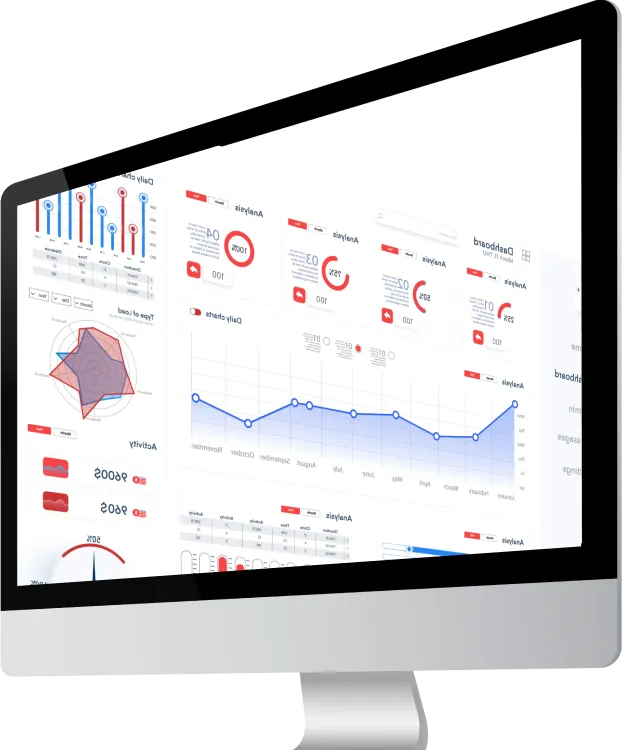Google Analytics
The beauty of the web is that everything is quantifiable. Thanks to Google Analytics, you can quantify everything. This tool allows you to know: who comes to your website, what are the most visited pages, where do your visitors come from, how long do they stay on your website and even, what do they buy? We can program objectives, see if they are achieved, such as seeing each time a user subscribes to your newsletter or performs a purchase. Access to all these statistics will allow you to see what is working well or not and what could be optimized. If you don’t have Google Analytics installed on your site, get it today, it’s free!
Adaptive version
People spend all their time on mobile devices. They do everything from their phones: searching, shopping, etc.
Having a “responsive” version simply means repositioning the elements of your site to the size of the screen (laptop, tablet, mobile). If you’re on your iPhone, you shouldn’t have to “zoom in” to read a text or click on a button.
If your site doesn’t have a version that adapts to mobile and tablet devices, you’re missing out on most of your potential traffic. And more traffic means more sales!
E-commerce
If you have a website, it’s probably because you sell products or services.
Are your products items that people could buy online? If so, it’s worth thinking about. It’ll save you time and keep your store open 24 hours a day!
If you’re selling a service, think about selling it as a subscription (monthly or yearly) so you only have to convince the customer once to sign up.
Today, many e-commerce sites sell worldwide. Imagine the revenue potential. Some have even managed to convert their products and services into virtual goods, such as eBooks or webinars. In these cases, your costs become practically zero, and you make even more profit!
Contact form
If your service or product won’t sell directly on an e-commerce platform because it’s too expensive, too big or too customized, consider implementing a contact form. This can be an online submission form with specific questions that will enable you to offer a price to the customer, an appointment booking form or an information request.
Remember to highlight this form so that visitors can access it quickly and easily. Use a color that stands out from the rest for the form (or the form submit button). This will encourage visitors to take action. After all, that’s the main purpose of your website!
Newsletter subscription
The newsletter is undoubtedly the best way to communicate with all your current and potential customers. With just one click, you can send a message to hundreds or even thousands of people in just a few minutes.
If you had a new promotion tomorrow that you wanted to tell all your customers about, how would you go about it? Calling them one by one would take days, if not months. To reach them via your Facebook page, you’ll have to pay, and it’s not 100% certain that they’ll receive it. Think about simply adding a field on your site to let people sign up for your newsletter.
On the other hand, adding a “Sign up for our newsletter” will probably not get you any results. Today, the word “newsletter” sounds like “advertising” in people’s ears. So you need to find a more creative way of getting them to sign up. Perhaps offering them something in return, such as “A free guide” or even telling them they’ll be the first to benefit from your upcoming services or products, would make them accept?
The most important thing is to put yourself in your visitor’s shoes and ask the question “What would the visitor like to receive in return, to encourage them to take action”.
Modern and up-to-date design
What’s cool today probably won’t be next year. Fashions change, especially when it comes to the web. Technologies evolve so rapidly that you need to keep your website’s look up to date if you want to stay ahead of the game.
Don’t forget that it’s the design of your website that will speak most to your visitor. If the “look” isn’t professional or up to date, chances are most of your customers won’t think your products or services are either.
Even if you’re the best lawyer in the world and you have a website that dates back to the 2000s, there’s no chance of a serious customer contacting you, because the image reflected by your website is what the visitor will remember.
In many cases, the majority of real potential customers will visit two or three competitors’ sites before making their choice. The first impression your site’s design reflects has a big influence on the choice these customers will make.
Content Self-Management System
Gone are the days when you had to call your webmaster every time you wanted to change something on your site. Today, there are so-called content self-management systems such as WordPress, Drupal, Joomla and others. These are platforms that allow you to connect to a dashboard that lets you update your site’s content without any programming knowledge.
Of course, if you want to make changes to the site’s structure or functionalities, it’s advisable to go through a programmer. But if you simply want to change a few texts or photos, or add or remove products or services, it will only take a few minutes.
Another advantage of these platforms is that they often have large communities with many extensions available. So if you ever want to add a new feature to your site, chances are someone has already created it for you!
A local or staging version
If your website is the heart of your business, it probably means that every minute your site is offline, you’re losing money. That’s why having a “test” version of your website is essential. This version can be “local” (on your computer on a simulated server) or on a web-accessible server.
Often, these versions are exact copies of your real site, allowing you to test the site when you make changes in structure or functionality, without affecting the real site.
You can work either with FTP to transfer files to the real website, or even better, use a GIT system to push changes to the server. In both cases, the important thing is to test carefully when making large-scale changes. That’s why you need a “test” version of your site.
Fairly fast response time
If your website is the heart of your business, it probably means that every minute your site is offline, you’re losing money. That’s why having a “test” version of your website is essential. This version can be “local” (on your computer on a simulated server) or on a web-accessible server.
Often, these versions are exact copies of your real site, allowing you to test the site when you make changes in structure or functionality, without affecting the real site.
You can work either with FTP to transfer files to the real website, or even better, use a GIT system to push changes to the server. In both cases, the important thing is to test carefully when making large-scale changes. That’s why you need a “test” version of your site.

